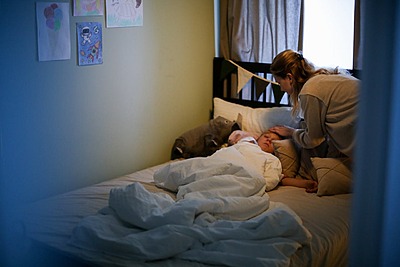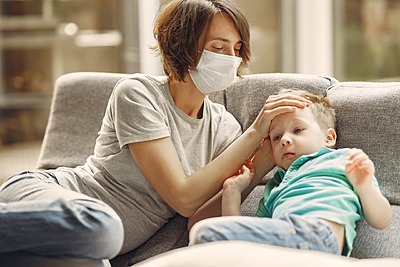A high fever in children is one of the most common symptoms of viral respiratory infections (such as the flu and colds) in both adults and children. While a slight increase above the normal temperature range usually does not cause concern for either the child or the parents, a significantly high reading on the thermometer is a reason to administer antipyretics (fever reducers) and consult a doctor.
In this article, we’ll explain why fever in children occurs during viral infections like the flu, discuss when it’s appropriate to reduce the fever, and provide guidance on how to do so effectively based on the child’s age and other factors.
Why does a child’s temperature rise?
Fever, or elevated body temperature, is the body’s response to a stimulus. During this time, the body purposefully adjusts its processes to raise the temperature. But why does this happen?
There are two main reasons for fever: infectious and non-infectious.
The flu and viral respiratory infections are infectious in nature and fall under the first category. In these cases, the rise in temperature helps the body fight the infection more effectively. Fever promotes the production of interferon (an “antiviral” protein), stimulates antibody formation, and strengthens the body’s defenses against viruses and bacteria.
If a fever helps the body combat illness, why reduce it at all? Let’s explore this further.
What to do?
First, don’t panic when you see a high number on the thermometer during a cold or flu. As we’ve explained, this is the body’s normal reaction to infection.
Incidentally, body temperature measured in the armpit can fluctuate between 36.5–37.5°C (97.7–99.5°F) throughout the day, and these values are still considered normal. So, there’s no need to rush to administer fever reducers or put the child to bed just because the thermometer shows something slightly above the “ideal” 36.6°C (97.9°F), especially if there are no other symptoms.
When should you lower a fever?
Fever refers to a temperature exceeding 38°C (100.4°F). It is often accompanied by chills, headaches, drowsiness, thirst, decreased urination, and reduced appetite. If the temperature is lower than this and the child is behaving normally with mild symptoms, it’s better to avoid giving fever reducers.

Even a temperature of 38°C (100.4°F) does not automatically require medication. Fever reducers should only be given in the following cases:
- The child has severe accompanying symptoms of fever, such as feeling unwell or showing signs of discomfort. In this case, it’s best to alleviate their distress without waiting for the fever to resolve on its own.
- The temperature reaches 39°C (102.2°F) or higher. At this level, fever can suppress the nervous system, lead to dehydration (which thickens the blood), and disrupt microcirculation in vital organs and tissues. For previously healthy children, this level of fever should always be reduced.
Guide how to reduce fever
Understanding why fever occurs and its accompanying symptoms is helpful, but most parents are more concerned with the question: How can I lower my child’s high fever?
The World Health Organization recommends only two medications for reducing fever in children: paracetamol or ibuprofen, as well as medicines that contain these as their main ingredients. These can lower the temperature by 1–2 degrees. Other medications should not be given, as they are only suitable for adults.
The choice of medication form depends on the child’s age and other factors:
For children under one year old
Rectal suppositories are typically recommended. Babies cannot take pills, and convincing them to swallow syrup can be difficult, even if it’s sweet and tasty. Suppositories often work faster than oral medications or injections in some cases. They are painless to administer, and parents can use them independently without medical assistance. Syrups and suspensions are also available for this age group, and some parents prefer them.
For children aged 1 to 6 years
Syrups are generally more convenient. At this age, children can swallow syrup more easily, and its sweetness makes it more palatable. However, syrups also contain sugar, making them unsuitable for children with diabetes or obesity. In such cases, suppositories in the correct dosage may be a better choice.
For children aged 6 years and older
Syrups and suppositories may seem too “babyish,” and some children dislike them. Tablets may also pose challenges, especially if the child has had a bad experience accidentally chewing one. In this case, powder medications for preparing hot drinks can be an alternative.
Some powders also include additional components, like phenylephrine for relieving nasal congestion and vitamin C to meet increased needs during illness. Such preparations, specifically designed for children aged 6–12, can help alleviate symptoms of colds and flu while improving overall well-being.
When to consult a pediatrician?

Modern paracetamol- and ibuprofen-based medications for children are available over the counter. However, their uncontrolled use is not safe. It’s essential to know how to administer these medications properly and recognize when to seek professional advice.
You should call a pediatrician if:
- The fever persists despite treatment.
- The child shows additional concerning symptoms, such as difficulty breathing, severe rash, or persistent lethargy.
There are no strict criteria for when to consult a doctor. Parents should monitor changes in the child’s condition and prioritize their well-being. If symptoms are mild but you’re unsure, it’s better to visit the pediatrician. The doctor can evaluate the child’s health, provide a diagnosis, and recommend appropriate treatment. They can also provide documentation for school or daycare, ensuring the child is not sent back to a group setting while ill.